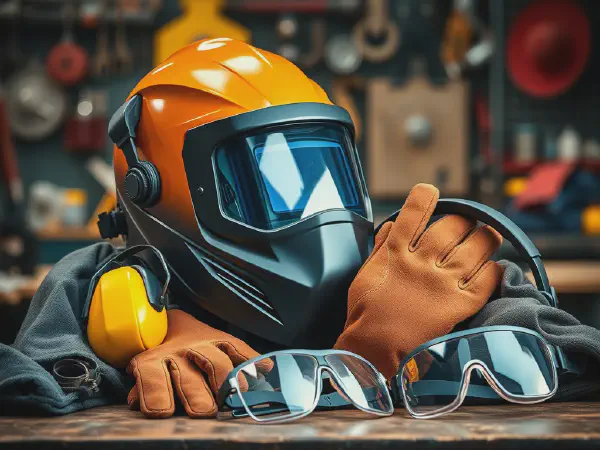Comprehensive Ultimate Guide to Welding Safety Equipment

Welding Safety Equipment: Essential Gear for a Safe Work Environment
Welding is a critical process in various industries, but it comes with its fair share of hazards. To ensure the safety of welders and those working nearby, Welding Safety Equipment is essential. This equipment protects against risks such as burns, electric shock, and inhalation of harmful fumes. Properly chosen and maintained welding safety equipment can significantly reduce the risk of accidents and injuries in the workplace.
The importance of using Welding Safety Equipment cannot be overstated. Welders are exposed to intense heat, bright light, and potentially harmful materials. Having the right protective gear can make a significant difference in mitigating these hazards. Whether you're a novice welder or have years of experience, understanding and utilizing welding safety equipment is crucial to maintain a safe working environment and ensure compliance with industry regulations.
There are numerous types of Welding Safety Equipment available, each serving a specific purpose. These include personal protective equipment (PPE), safety measures for the welding equipment itself, adherence to safety standards, and having emergency procedures in place. By familiarizing yourself with these aspects, you empower yourself to work safely and efficiently and protect those around you.
Ultimately, Welding Safety Equipment is not just an option; it is a necessity. Employers have a responsibility to provide appropriate safety gear and training to their workers, while also ensuring that all safety measures are in place. By prioritizing safety, the welding industry can continue to thrive while minimizing the risks associated with this essential trade.
In this detailed article, we will explore different categories of Welding Safety Equipment, including personal protective equipment, equipment safety checks, relevant safety standards, emergency procedures, and training requirements to ensure a safe welding environment.
Personal Protective Equipment (PPE) for Welders
Welding masks and helmets are vital components of welder PPE. They protect the face and eyes from harmful UV and infrared radiation emitted during the welding process, as well as from flying sparks and debris. A quality welding helmet should offer adjustable darkening shades to accommodate the type of welding and the welder's comfort. In many cases, an auto-darkening helmet is recommended for its convenience and safety features.
Protective gloves for welding are designed to shield the hands from heat, cuts, and abrasions. Welders should choose gloves made from high-quality materials that are both durable and flexible. The gloves should allow for dexterity while offering adequate protection against molten metal and other hazards. Additionally, welders need to replace worn or damaged gloves to maintain optimal safety standards.
Safety clothing and boots for welders are essential to protect against burns and electrical hazards. Flame-resistant clothing made from materials such as cotton or synthetics can provide adequate coverage, while steel-toed boots protect the feet from heavy falling objects. It is crucial that the clothing fits properly and does not have loose ends that could catch fire or become entangled in equipment.
Respiratory protection is necessary to guard against inhaling welding fumes, which can be toxic. Welders should use respirators or ventilation systems to ensure a safe breathing environment. Proper respiratory protection not only helps to prevent short-term effects, such as headaches and dizziness, but also long-term health issues like respiratory diseases. Choosing the right filtration system for the specific materials being welded is critical for adequate protection.
Welding Equipment Safety Checks
Routine inspection of welding machines is crucial to ensure they are functioning correctly and safely. Regular checks can help identify any signs of wear or malfunction that could escalate into dangerous situations if left unaddressed. Welders should be trained to perform these inspections and report any concerns to their supervisors immediately.
Checking gas cylinders for leaks plays a vital role in maintaining a safe workspace. Welders must inspect gas cylinders for damage and use soapy water to check for leaks around connections. Proper storage and handling of gas cylinders also contribute to overall safety. Keeping cylinders upright and secured prevents accidents that could lead to explosions or fires.
Ensuring electrical safety in welders involves checking cords, plugs, and connections for signs of wear or damage, which could lead to electric shock. All electrical components should be grounded properly to minimize the risk of electrical hazards. Regular maintenance and adherence to electrical safety standards can help prevent incidents on the job site.
Evaluating ventilation systems in welding areas ensures that harmful fumes and gases are adequately dispersed. Proper ventilation helps improve air quality and reduces the risk of exposure to toxic substances. Employers should conduct regular assessments of ventilation systems and provide necessary upgrades or maintenance to keep them operating efficiently.
Safety Standards and Regulations
OSHA guidelines for welding safety outline the responsibilities of employers and employees to ensure a safe working environment. These guidelines address hazards associated with welding, including materials handling, personal protective equipment, and ventilation requirements. Compliance with OSHA standards is critical for every facility involved in welding operations.
ANSI (American National Standards Institute) standards for welding equipment set forth specifications regarding the design and performance of safety gear. Compliance with these standards helps ensure that the equipment being used meets safety requirements that protect both the user and the environment. Employers should stay updated on ANSI standards to ensure their operations meet industry expectations.
State regulations on welding safety may vary, but they generally follow OSHA and ANSI guidelines. It's important for welding companies to be aware of local regulations that pertain to workplace safety, as non-compliance can lead to citations and legal repercussions. Regular audits and training sessions can help maintain compliance with state-level safety regulations.
Industry best practices for compliance with welding safety standards include ongoing training, proper maintenance of equipment, routine safety audits, and fostering a culture of safety within the organization. Companies should prioritize educating their employees on safe practices to promote both efficiency and safety in welding operations.
Emergency Procedures and First Aid
First aid kits for welders should be readily accessible at all worksites. These kits should be stocked with items specifically tailored to treat welding-related injuries, including burn ointments, sterile dressings, and eye wash solutions. Regularly checking and replenishing first aid kits is essential for preparedness during emergencies.
Emergency response plans for welding accidents must be in place to ensure the safety of all personnel. Such plans should outline procedures for reporting incidents, administering first aid, and evacuating the premises if necessary. Conducting drills and reviews of these plans can help reduce response times during actual emergencies.
Fire safety protocols in welding environments are critical due to the high risk of fires from sparks and heat generated during the welding process. Workspaces should be equipped with appropriate fire extinguishers, and flammable materials should be removed or stored safely away from welding operations. Regularly conducting fire safety drills can prepare employees to respond quickly in case of an incident.
Dealing with chemical exposure in welding is vital for worker health and safety. Welders should be trained to recognize signs of chemical exposure and understand the proper methods for decontamination. Ensuring access to safety data sheets (SDS) for all materials used in the welding process can aid in proper handling and emergency response.
Training and Education in Welding Safety
Welding safety training programs are essential to educate workers on the safe practices and risks associated with welding. These programs should cover proper use of personal protective equipment, emergency procedures, and operating welding machinery safely. Regular training sessions can help keep workers informed about new safety practices and standards.
Certification courses for welders often include comprehensive safety training as part of the curriculum. Obtaining certification not only demonstrates skill proficiency but also indicates a commitment to safety and compliance within the industry. Many employers require certified welders to maintain high standards of work and safety.
Hands-on training for PPE usage is crucial for welders to understand the proper fit and function of their gear. Training sessions should provide practical exercises that allow workers to experience how their equipment protects them against welding hazards. This understanding helps foster a culture of safety and minimizes risks on the job.
Continuous education on welding safety advancements is necessary for welders to keep pace with evolving technologies and regulations. Industries should encourage participation in workshops, seminars, and online courses to maintain a safe work environment and stay updated on best practices.
